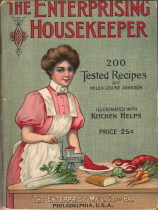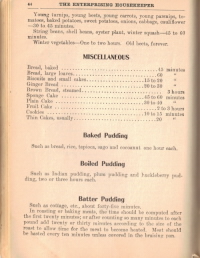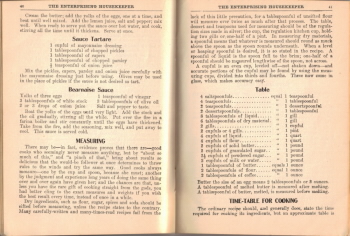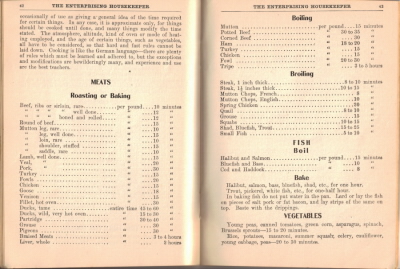 Here are pages 40, 41, 42, 43 and 44 from the vintage booklet The Enterprising Housekeeper from the sixth edition (1906).
Here are pages 40, 41, 42, 43 and 44 from the vintage booklet The Enterprising Housekeeper from the sixth edition (1906).
Measuring
There may be–in fact, evidence proves that there are–good cooks who seemingly never measure anything, but by “about so much of this,” and “a pinch of that,” bring about results so delicious that the would-be follower at once determines to throw rules to the winds and try the same way. Good cooks always measure–one by the cup and spoon, because she must; another by the judgment and experience long years of doing the same thing over and over again have given her; and the chances are that, unless you have the rare gift of cooking straight from the gods, you had better cling to the exact measures and weights if you wish the best result every time, instead of once in a while.
Dry ingredients, such as flour, sugar, spices and soda should be sifted before measuring, unless the recipe states to the contrary. Many carefully-written and many-times-read recipes fail from the lack of this little precaution, for a tablespoonful of unsifted flour will measure over twice as much after that process. The table, dessert and teaspoons used for measuring should be of the regulation sizes made in silver; the cup, the regulation kitchen cup, holding two gills or one-half of a pint. In measuring dry materials, a spoonful means that whatever is measured should round as much above the spoon as the spoon rounds underneath. When a level or heaping spoonful is desired, it is so stated in the recipe. A spoonful of liquid is the spoon full to the brim; one-half of a spoonful should be measured lengthwise of the spoon, not across.
A cupful is an even cup, leveled off–not shaken down–and accurate portions of the cupful may be found by using the measuring cups, divided into thirds and fourths. These now come in glass, which makes accuracy easy.
Table
4 saltspoonfuls . . . equal 1 teaspoonful
4 teaspoonfuls . . . equal 1 tablespoonful
2 teaspoonfuls . . . equal 1 dessertspoonful
2 dessertspoonful . . . equal 1 tablespoonful
8 tablespoonfuls of liquid . . . equal 1 gill
6 tablespoonfuls of dry material . . . equal 1 gill
2 gills . . . equal 1 cupful
2 cupfuls or 4 gills . . . equal 1 pint
4 cupfuls of liquid . . . equal 1 quart
4 cupfuls of flour . . . equal 1 quart
2 cupfuls of solid butter . . . equal 1 pound
2 cupfuls of granulated sugar . . . equal 1 pound
2 1/2 cupfuls of powdered sugar . . . equal 1 pound
2 cupfuls of milk or water . . . equal 1 pound
1 tablespoonful of butter . . . equals 1 ounce
2 tablespoonfuls of flour . . . equal 1 ounce
2 tablespoonfuls of coffee . . . equal 1 ounce
Butter the size of an egg means 2 tablespoonfuls or 2 ounces.
A tablespoonful of melted butter is measured after melting.
A tablespoonful of butter, melted, is measured before melting.
Time-Table For Cooking
The ordinary recipe should, and generally does, state the time required for cooking its ingredients, but an approximate table is occasionally of use as giving a general idea of the time required for certain things. In any case, it is approximate only, for things should be cooked until done, and many things modify the time stated. The atmosphere, altitude, kind of oven or mode of heating employed, and the age of certain things, such as vegetables, all have to be considered, so that hard and fast rules cannot be laid down. Cooking is like the German language–there are plenty of rules which must be learned and adhered to, but the exceptions and modifications are bewilderingly many, and experience and use are the best teachers.
[RecipeCurio Note: See the image below for the Roasting & Baking Charts, you can click it to view a larger copy]
Bake
Halibut, salmon, bass, bluefish, shad, etc., for one hour.
Trout, pickerel, white fish, etc., for one-half hour.
In baking fish do not put water in the pan. Lard or lay the fish on pieces of salt pork or fat bacon, and lay strips of the same on top. Baste with the drippings.
Vegetables
Young peas, canned tomatoes, green corn, asparagus, spinach, Brussels sprouts–15 to 20 minutes.
Rice, potatoes, macaroni, summer squash, celery, cauliflower, young cabbage, peas–20 to 30 minutes.
Young turnips, young beets, young carrots, young parsnips, tomatoes, baked potatoes, sweet potatoes, onions, cabbage, cauliflower–30 to 45 minutes.
String beans, shell beans, oyster plant, winter squash–45 to 60 minutes.
Winter vegetables–One to two hours. Old beets, forever.
 [RecipeCurio Note: See the image at the right side for the Miscellaneous Chart, you can click it to view a larger copy]
[RecipeCurio Note: See the image at the right side for the Miscellaneous Chart, you can click it to view a larger copy]
Baked Pudding
Such as bread, rice, tapioca, sago and cocoanut one hour each.
Boiled Pudding
Such as Indian pudding, plum pudding and huckleberry pudding, two or three hours each.
Batter Pudding
Such as cottage, etc., about forty-five minutes.
In roasting or baking meats, the time should be computed after the first twenty minutes; or after counting so many minutes to each pound add twenty or thirty minutes according to the size of the roast to allow time for the meat to become heated. Meat should be basted every ten minutes unless covered in the braising pan.
 More Recipes For You To Enjoy:
More Recipes For You To Enjoy:





